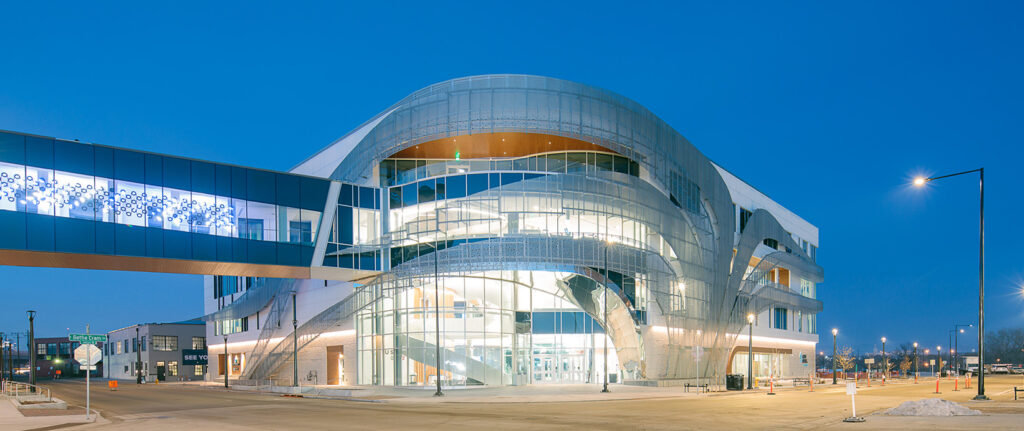
MAKING WAVES
Hydro houses water research and education at CSU Spur.
By Coleman Cornelius | Feb. 13, 2023
IDEAS AND INNOVATIONS are starting to ripple through Hydro, the last and largest of three new buildings to open at the CSU Spur campus in north Denver. The campus, developed by the CSU System, has launched over the past year at the National Western Center, built with $200 million from the Colorado Legislature.
Hydro opened in January and is dedicated to research, partnerships, policy discussions, and public education related to water – including the topics of scarcity and management challenges in Colorado and the increasingly parched West. The building joins Vida, which focuses on health, and Terra, with programs tied to food and agriculture.
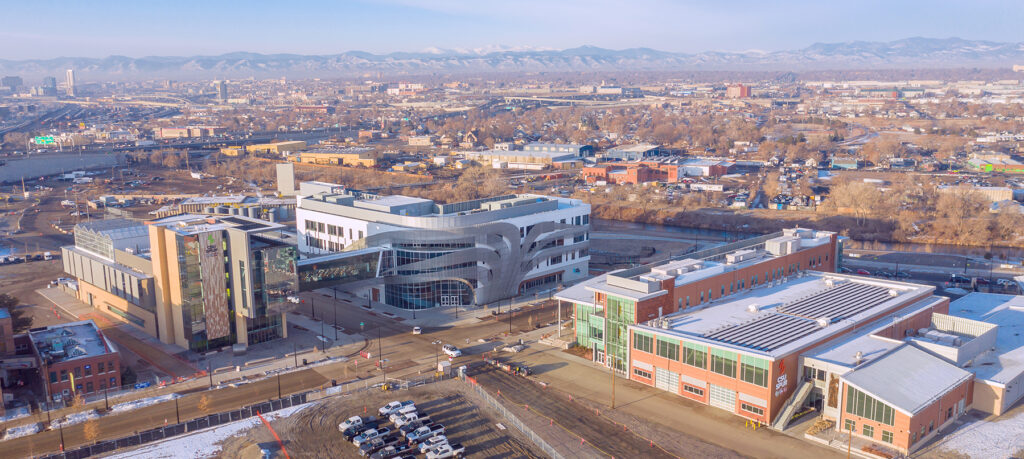
An aerial view shows the Terra, Hydro, and Vida buildings at CSU Spur. Photo: Matthew Staver
Unlike most university campuses, CSU Spur is not designed chiefly to confer academic degrees, although several CSU courses and degree programs are sprouting there.
Instead, its mission is to promote public education, scientific research, and industry partnerships that spark lifelong learning and innovation in the spheres of food, water, and human and animal health. These are areas of expertise for the CSU System – and likewise present some of the great global challenges this and future generations must tackle to sustain humanity and the planet. For that reason, many educational programs and exhibits at CSU Spur are meant to inspire schoolchildren and young adults toward college and careers in the three critical fields.
“It’s a campus we hope will stimulate new ideas, conduct research that will lead to new solutions, and foster conversations that will lead to new approaches to solving problems,” Tony Frank, chancellor of the CSU System, said at the opening celebration for Hydro. “One of the foundational elements of this campus is to send young people off to pursue their dreams with the wind of a college education filling their sails.”
The campus mission is unique, yet it exemplifies the fundamental work of a land-grant university: “New knowledge will be discovered here. It will be passed to the next generation, and it will be applied for the benefit of society,” Frank said.
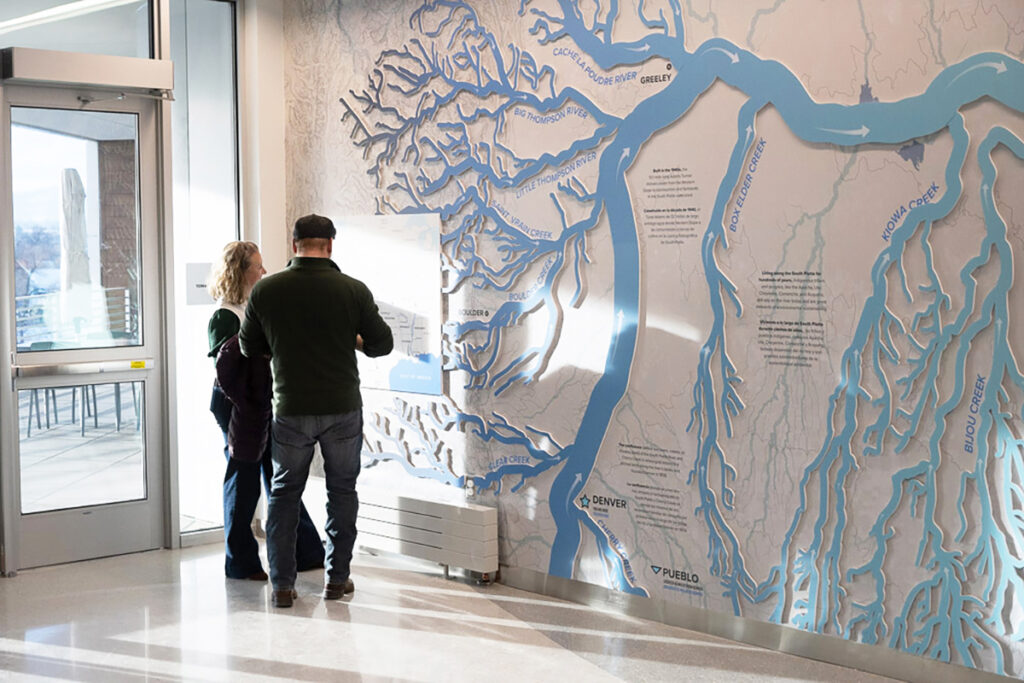
An exhibit illustrates the South Platte River and its tributaries. Photo: Kevin Samuelson / CSU System.
When Hydro opened, some 18,000 visitors – including thousands of schoolkids – already had toured the first two buildings at CSU Spur.
Hydro opened coinciding with the 117th annual National Western Stock Show – significant because CSU Spur germinated a decade ago, when leaders of the stock show and the city and county of Denver sought ways to retain and improve the iconic Colorado event on its historic grounds.
The goal that emerged: Draw together key partners, including the CSU System, to establish the National Western Center as a year-round destination for education and entertainment, with a spotlight on Western heritage and the future of agriculture. The center’s marquee event is the National Western Stock Show, held annually in January. CSU Spur is the educational anchor at the National Western Center and comprises the first cluster of new buildings to rise there; it joins new and improved stockyards and a stockyards event center, which are hallmarks of the stock show. Buildout of the National Western Center will continue in years to come.

In Hydro, we are creating a community that connects creative minds in policy, research, education, and innovation in pursuit of solutions to regional and global water challenges.”
— Jocelyn Hittle, associate vice chancellor for CSU Spur
Emphasizing the interconnections of food, water, and health, U.S. Secretary of Agriculture Tom Vilsack was among the public officials to speak at the Hydro opening. Vilsack and his wife, Christie, had influential roles as advisers when CSU Spur was conceptualized.
“These buildings are not just incredible educational opportunities. They’re not just a place to celebrate science and the arts. They’re not just a place to connect rural and urban,” Vilsack told a crowd of several hundred people, many jangling cowbells to cheer campus completion. “This is a center of transformation,” he said. “This is a center for a brighter and better future, not just for Colorado agriculture, not just for United States agriculture, but also for global agriculture. It’s that important.”
The largest partner in Hydro is Denver Water. The oldest and largest water utility in Colorado, it supplies water to 1.5 million people in Denver and many of its suburbs. Denver Water occupies the entire third floor of the four-story building with its new water quality laboratory.
Each year, the water quality lab conducts more than 200,000 tests on samples drawn from Denver Water’s collection and distribution system – from forest to faucet – in order to monitor water quality and to ensure purity for customers. About half of Denver’s water comes from the Upper South Platte River Basin and half comes from the Upper Colorado River Basin. Hydro visitors may watch this testing as the water quality laboratory gets fully up and running this spring.
“We’re really excited to move in and begin operations in partnership with CSU,” said Jim Lochhead, Denver Water’s chief executive officer and manager. “Our customers will benefit from the research, the innovation, the policy, and the education at Hydro. We get to collaborate with a research university. And CSU has the practical experience of dealing with the real world of a water utility. So everybody wins in this collaboration.”
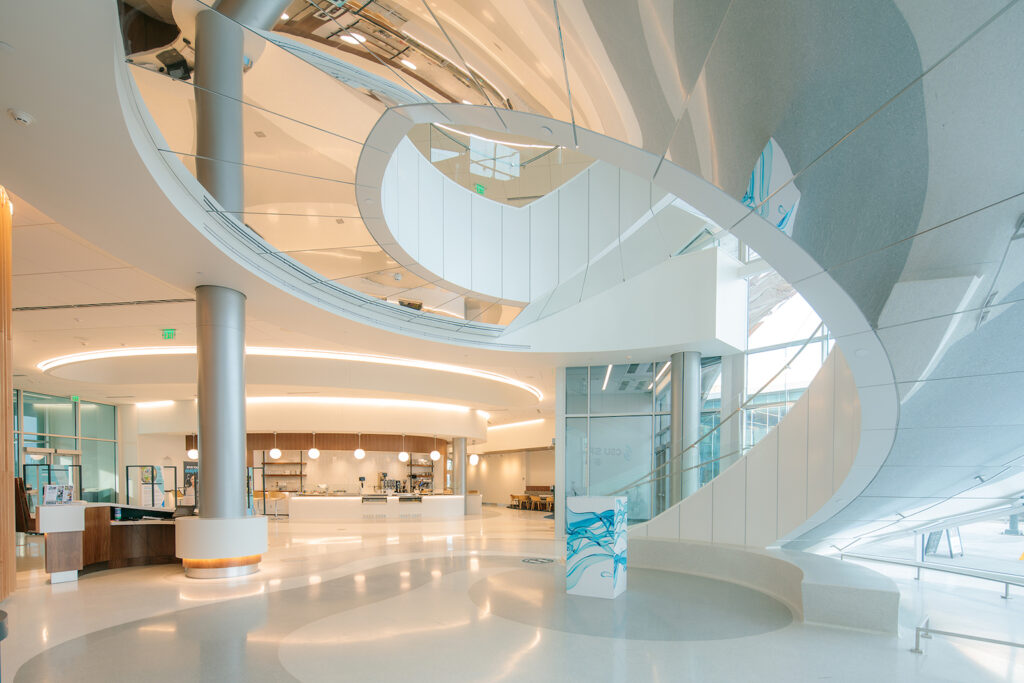
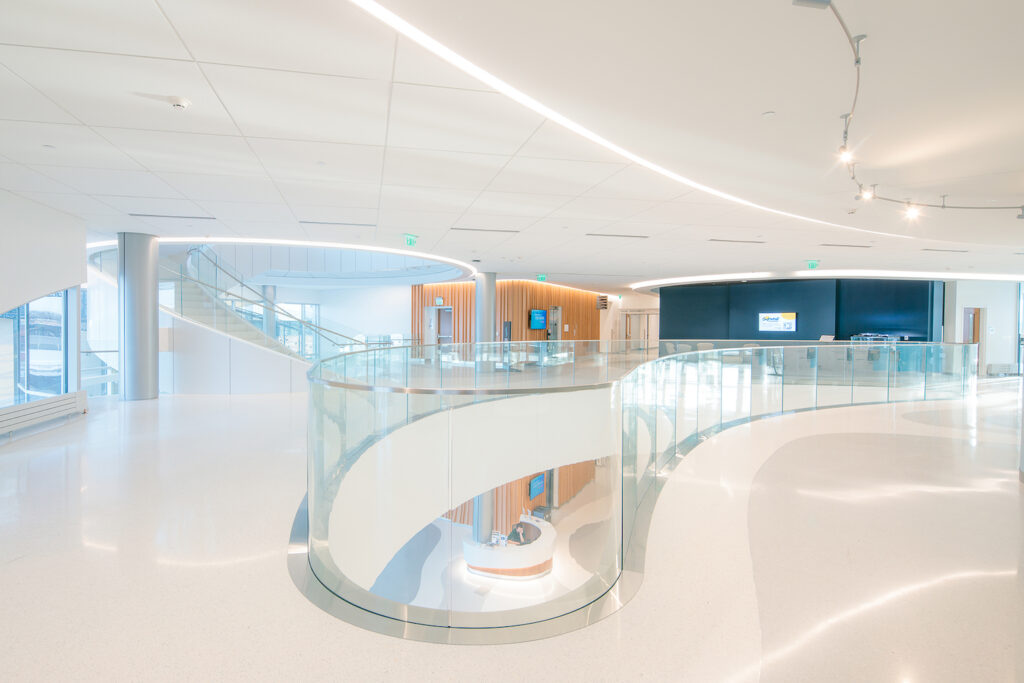
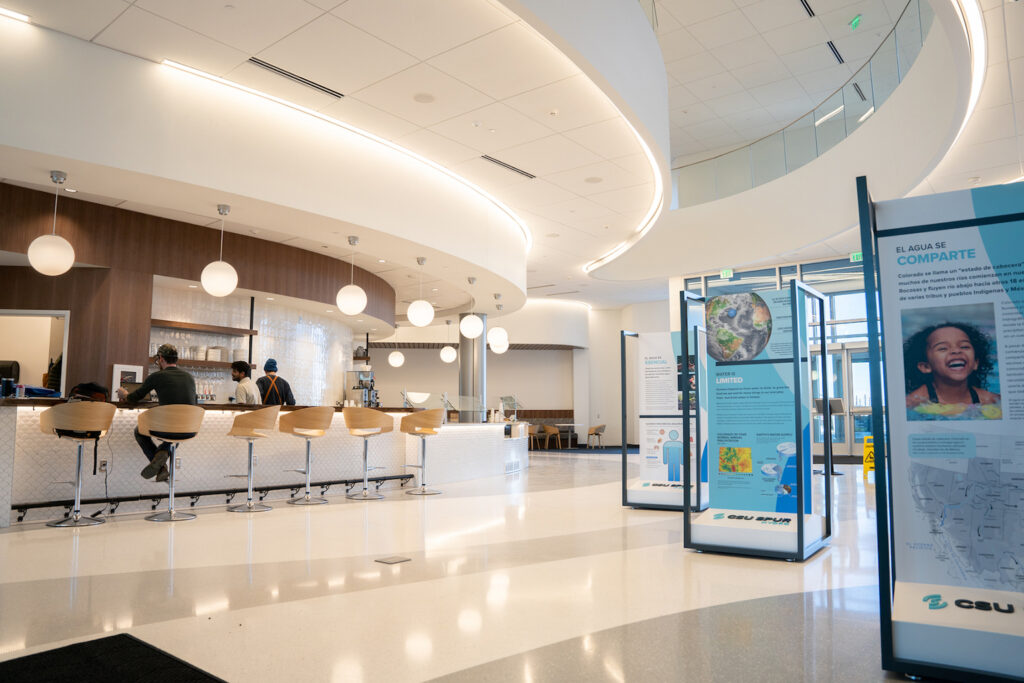
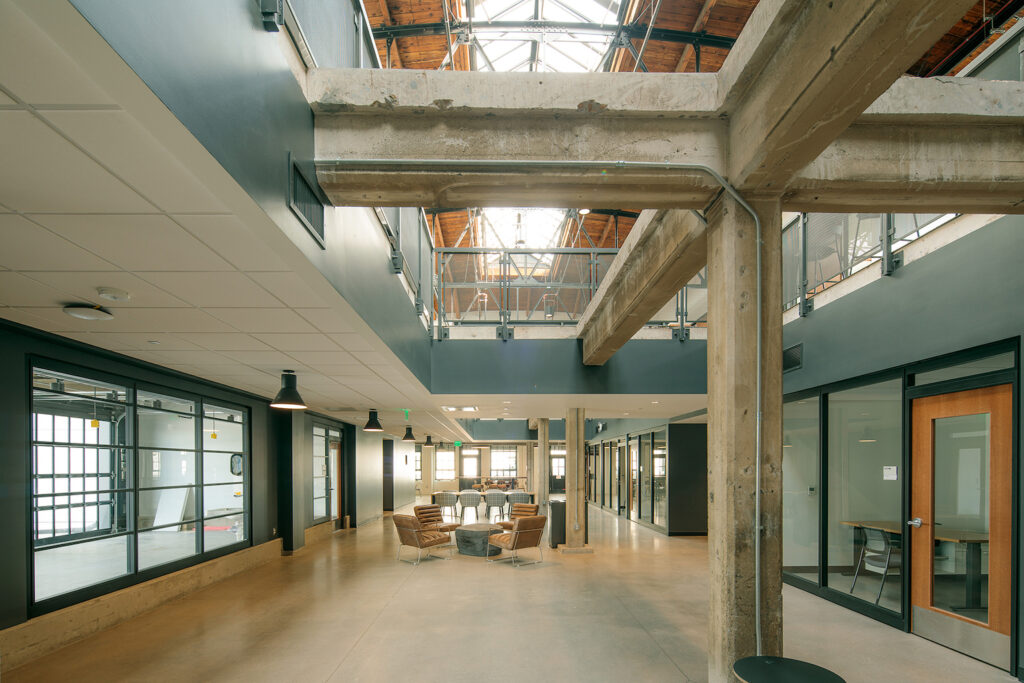
Bright spaces define the Hydro building, including the Western Daughters Kitchen on the first floor (top right), office spaces and studios in “The Shop” (bottom right), and the future location of a water feature called “Swirl” (top left). / Top right photo: Kevin Samuelson / CSU System. All other photography: Matthew Staver.
Bright spaces define the Hydro building, including the Western Daughters Kitchen on the first floor (third from top), office spaces and studios in “The Shop” (bottom), and the future location of a water feature called “Swirl” (top). / Photo third from top: Kevin Samuelson / CSU System. All other photography: Matthew Staver.
Another large laboratory is occupied by the Water Technology Accelerator Platform, known as the Hydro Water TAP. The lab is part of CSU’s One Water Solutions Institute in Fort Collins and is nationally unique in working with industry partners to examine new technologies for cleaning and reusing water from a variety of sources – with the ability to test innovations at flow levels that mimic real-world water management scenarios. Technologies may be tested using gray water, storm water, roof runoff, and water trucked in from other sources; for instance, water used in hydraulic fracturing for oil and gas extraction.
Research at the Hydro Water TAP is guided by the “One Water” principle that water is valuable in all its forms when effectively treated, matched for appropriate use, and managed through integrated systems. The laboratory’s first project is studying equipment to treat storm water to potable quality levels for drinking, said Sybil Sharvelle, a CSU professor of civil and environmental engineering and lead scientist at the Water TAP. All the work is on display for visitors to see.
“What we really want to do is think about these water sources and treat them to a level for the use needed, then bring the new technology into practice in the market,” Sharvelle said. The concept already is applied in Hydro, where toilets are flushed with gray water captured from sinks in the building – and air is warmed with heat captured from Denver wastewater.
Elsewhere in the 125,000- square-foot building, the CSU Biomanufacturing and Biotechnology Laboratory trains university students in bioprocessing that may be applied in the food, energy, and pharmaceutical sectors. There are seven laboratories that may be leased by outside organizations for their own research projects. And, atop Hydro, scientists are examining rooftop agrivoltaics, or rooftop fruit and vegetable cultivation under and around rooftop solar panels – a concept designed to take advantage of urban spaces for targeted food and clean energy production.
Much of the space in Hydro is used for teaching labs, classrooms, meeting rooms, and offices occupied by both CSU System employees and those of water-focused nonprofits partnering with the System.
VISIT CSU SPUR
- CSU Spur is at 4817 National Western Drive in Denver.
- The campus is free and open to the public.
- Hours are Monday-Friday, 9 a.m. to 5 p.m.
- CSU Spur is open the second Saturday of each month, with activities and demonstrations from 10 a.m. to 3 p.m.
- For more information – and to schedule school visits and private events – visit csuspur.org.
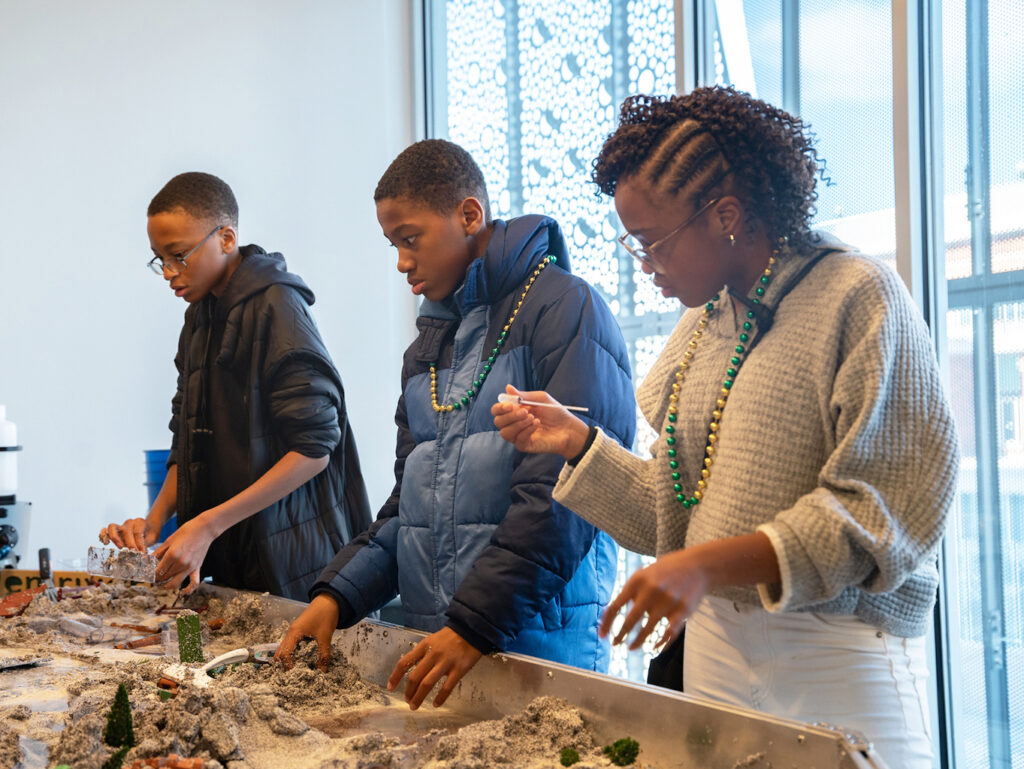
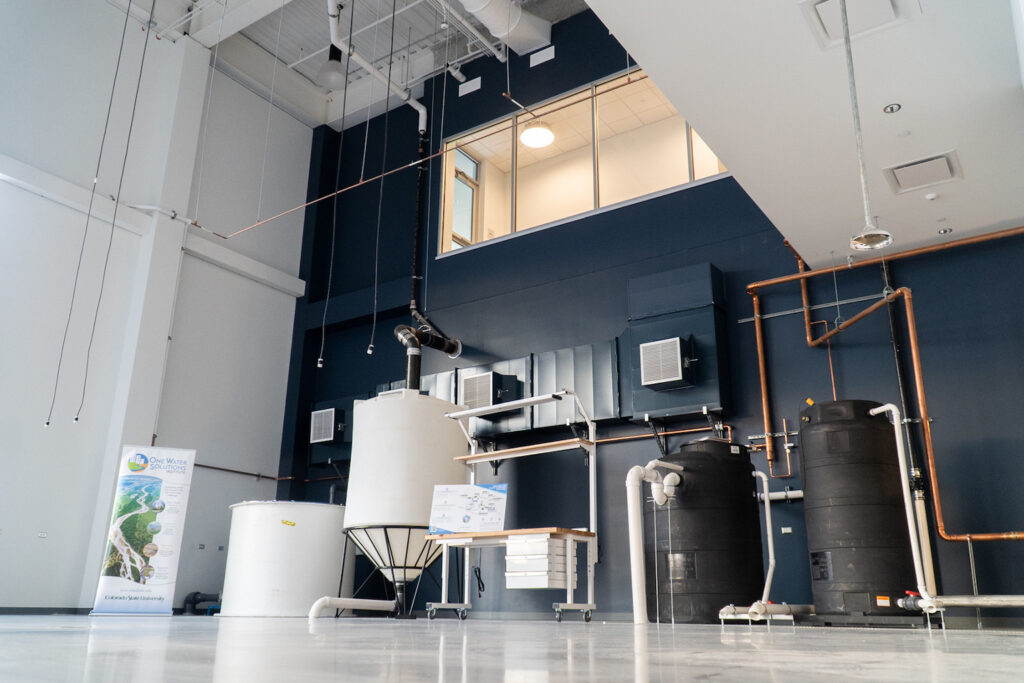
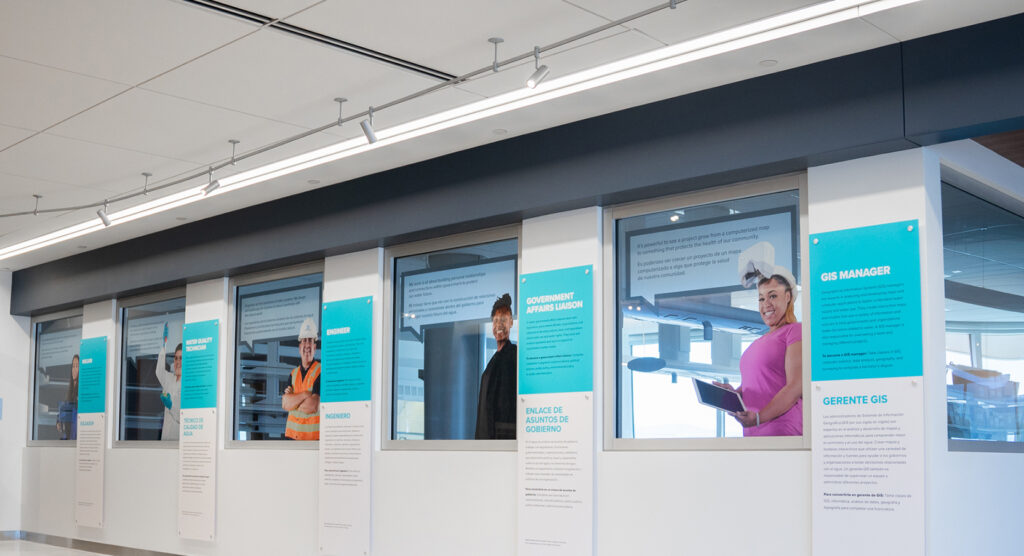
Left: A Hydro stream table demonstrates erosion. Top right: The Hydro Water TAP tests new treatment technologies. Bottom right: A display in Hydro shows water related careers. Photography: Kevin Samuelson / CSU System
Top: A Hydro stream table demonstrates erosion. Middle: The Hydro Water TAP tests new treatment technologies. Bottom: A display in Hydro shows water related careers. Photography: Kevin Samuelson / CSU System
Of interest to visitors are Hydro’s educational exhibits, starting with landscape architecture in the building’s Backyard that will illustrate Colorado’s major watersheds – a matter of yards away from one vital waterway, the South Platte River, where many educational programs will occur. Inside, a stream table uses sand and running water to teach kids how rivers shape the landscape. Another interactive exhibit lets visitors learn about river critters that indicate water quality. And, among other displays, a fish tank from Trout Unlimited teaches visitors about baby trout, called fry, which will be raised at Hydro and released into the South Platte River.
The educational mission is furthered in other ways: Hydro is home base for the CSU Master of Agribusiness and Food Innovation Management program. It also houses a site for College Track, a nationwide nonprofit that supports first-generation students on their paths to and through college.
Hydro also is notable for its emphasis on the arts. There are multiple spaces in the building for creation and display of both visual and performing arts. Three of CSU Spur’s permanent art installations will be at Hydro: “Swirl,” a stream of water that will drop from the third floor to the foyer, demonstrating fluid dynamics as it spirals downward; “Whirlpool,” a vibrant mural of blue hues; and “Crescendo,” a group of massive wave forms in the Hydro Backyard. The visual arts likewise will come to life in several artist studios in The Shop, a wing of the Hydro building; here, visitors may watch artists at work.


Left: CSU Pueblo’s Ballet Folklorico performs in Confluence Theater. Right: Artwork called “Rotation Index” is installed in the bridge between Terra and Hydro. Photography: Kevin Samuelson / CSU System
Top: CSU Pueblo’s Ballet Folklorico performs in Confluence Theater. Bottom: Artwork called “Rotation Index” is installed in the bridge between Terra and Hydro. Photography: Kevin Samuelson / CSU System
Venues for the performing arts – including music and dance – likewise are available at Hydro. Among these is the Confluence Theater, an auditorium that seats 230 and may be used by both university and outside groups for performances, lectures, and conferences. On Hydro opening day, CSU Pueblo’s Ballet Folklorico inaugurated the theater with traditional Mexican folk dances.
“It’s really important that when we’re talking about engaging people in food, water, and health, we include people from all disciplines,” said Jocelyn Hittle, associate vice chancellor for CSU Spur and a driving force behind its creation. “You can come at all these things through the arts and contribute meaningfully to ideas and our innovation ecosystem here at Spur.”
Notably, Hydro’s spaces offer sweeping views of Colorado’s snow-capped mountains.
“Imagine the snow up there,” Hittle said, looking westward through a wall of windows while touring the building on a sunny winter day. “It melts, and much of it comes through right here in the South Platte River and goes to municipalities and out to productive agricultural lands. This is a remarkable setting to explore that story.”
Photo at top: A staircase spirals from the foyer to the third floor in Hydro. Photo: Matthew Staver.
SHARE
